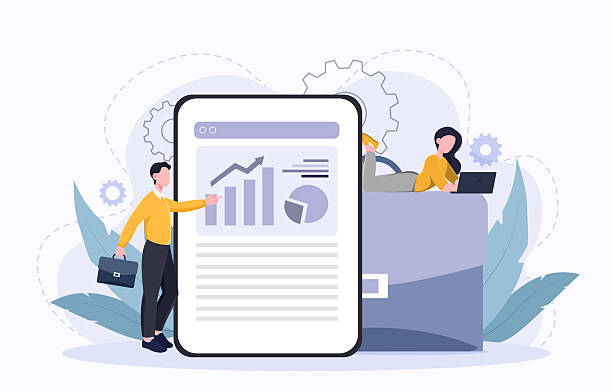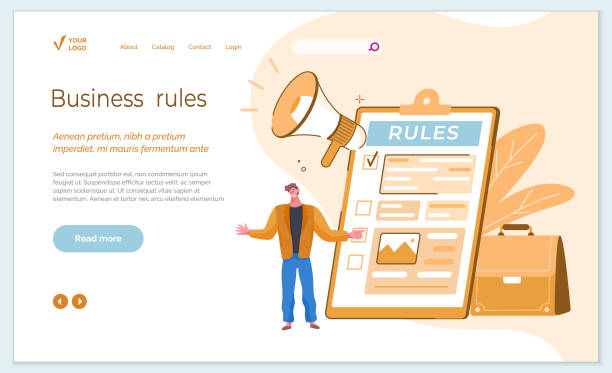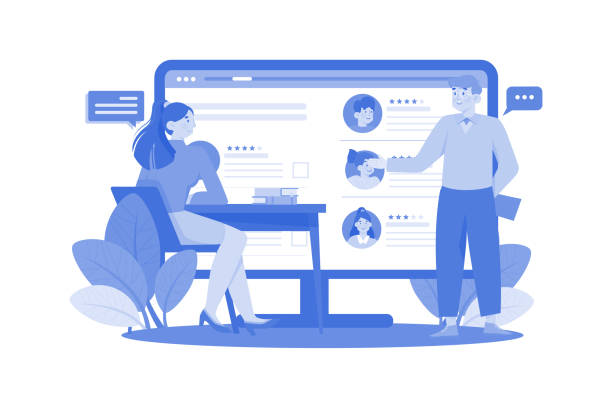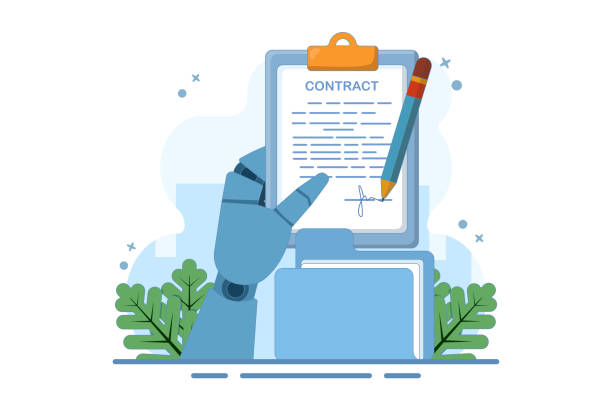Why is Multilingual Website Design Crucial for Modern Businesses?

Today, in the interconnected digital world, access to global markets has become more important than ever.
#Multilingual_Website_Design is no longer a competitive advantage, but a necessity for any business looking to expand its operations and attract more audiences worldwide.
A website available in only one language misses countless opportunities to connect with potential customers.
This is especially important in countries like Iran, where many users are also proficient in other languages.
The main goal of this approach is to provide a seamless and convenient user experience for users of any language and culture.
This section provides an explanation of the importance and necessity of multilingual websites.
This action not only helps increase website traffic but also strengthens the brand internationally.
A multilingual site can directly impact a business’s conversion rate and revenue generation.
From this perspective, every multilingual web design project must be accompanied by careful planning and a deep understanding of the needs of international users.
This is an important educational step to understand your business’s position in the global web ecosystem.
Do you have an online store, but your sales are not as expected? Rasaweb solves your problem forever with professional e-commerce website design!
✅ Significant increase in conversion rates and sales
✅ Exceptional user experience for your customers
⚡ Click to get a free consultation with Rasaweb!
Competitive Advantages and Search Engine Optimization with a Multilingual Website

Implementing multilingual website design is not just about content translation; it is a comprehensive strategy for increasing online visibility and presence in global markets.
One of the biggest advantages is a significant improvement in international SEO.
By creating different language versions of your website, you can rank for various keywords in different languages, which leads to increased organic traffic.
Search engines like Google use hreflang tags to understand different language versions of a page and serve the most appropriate version to users based on their geographical location and preferred language.
This is an analytical approach that allows businesses to precisely target their audience.
In addition to SEO, a multilingual website improves accessibility and user convenience for non-native visitors, which in turn leads to increased customer trust and loyalty.
This guidance helps businesses gain a better understanding of how to leverage this strategy to outperform competitors and ultimately achieve sustainable growth and development.
Technical Considerations in Designing and Implementing Multilingual Websites

The multilingual website design process has its own technical complexities that require careful planning.
Choosing the right URL structure is one of the most important decisions.
There are three main methods for this: subdomains, subdirectories, and country code top-level domains (ccTLDs).
Each of these methods has its own advantages and disadvantages in terms of SEO and management.
For example, using subdirectories (like yoursite.com/fa/) is generally considered the best option for internal SEO.
Also, correctly implementing the hreflang tag in the header of each page to declare the relationship between different language versions and help search engines understand the site’s structure is crucial.
This section provides a technical explanation for developers and website administrators.
Choosing a Content Management System (CMS) that is designed from the outset to support multilingualism or has powerful plugins for this purpose is also very important.
These elements form the backbone of a successful multilingual website design, and neglecting any of them can lead to serious problems in the future.
| Structure | Example | Advantages | Disadvantages |
|---|---|---|---|
| Subdirectories | example.com/en/ |
Strong SEO, easy management, shared Authority | More complex server configuration |
| Subdomains | en.example.com |
Independent hosting, easy to change | Slightly weaker SEO, requires separate DNS management |
| ccTLDs | example.fr |
Very strong local SEO, local brand identity | High cost, multiple domain management, requires purchasing a domain for each country |
Content Translation Strategies and Quality Assurance

One of the most important parts of multilingual website design is content translation.
Mere word-for-word translation is not enough; the meaning, tone, and original message of the content must be correctly conveyed in the target language.
There are two main translation methods: machine translation and human translation.
While machine translation (with tools like Google Translate) can be fast, it usually lacks the necessary quality, especially for specialized or sensitive content.
Human translation by native speakers and subject matter experts yields the best results in terms of accuracy, fluency, and cultural understanding.
This method ensures that the content is not only linguistically correct but also culturally appropriate and accepted.
After translation, review and editing by a native speaker are crucial to ensure final quality and the absence of spelling or grammatical errors.
This guidance helps businesses ensure the quality of their content in all languages.
Neglecting translation quality can harm your website’s credibility and reduce the user experience.
Are you disappointed with your online store’s low conversion rate?
Rasaweb is your definitive solution with professional e-commerce website design!
✅ Increase your sales and revenue
✅ Exceptional user experience for your customers
⚡ Get a free consultation now!
The Importance of Localization Beyond Mere Translation

Successful multilingual website design goes beyond simple text translation and enters the realm of Localization.
Localization means fully adapting the website’s content and design to the culture, habits, and expectations of the audience in a specific region.
This includes changes in date and time formats, currency, measurement systems, images, colors, and even the stories and examples used in the content.
For instance, an image that has a positive meaning in one culture might cause misunderstanding or even be offensive in another.
Localization not only helps increase engagement with the audience but also makes users feel that the website has been specifically designed for them.
This approach transforms questionable content into an entertaining and relevant experience.
It’s deeper than a mere translation; in fact, it means recreating the experience for each target market.
Neglecting this aspect can lead to failure even with a technically high-quality multilingual website.
International SEO Optimization for Multilingual Websites

To ensure your multilingual website design is visible in search engines, you must carefully perform international SEO optimization.
This section includes several key steps.
Firstly, the correct use of the hreflang tag, as mentioned earlier, is essential for informing Google and other search engines about different language versions of a page.
Secondly, creating separate XML sitemaps for each language and submitting them to Google Search Console can help improve the crawling and indexing of your pages.
Thirdly, keyword research for each language separately is important; keywords that are popular in one language may not be applicable or may have better synonyms in another.
This is a specialized and very important aspect.
Also, ensuring high loading speed for all language versions, website responsiveness across different devices, and a positive user experience are other factors influencing SEO.
This guidance helps your website stand out in international search results and more effectively reach your target audience.
Choosing the Right Platform and Content Management System for Multilingual Design

Choosing the right platform and Content Management System (CMS) is a crucial step in the multilingual website design process.
Some CMSs like WordPress, using plugins such as WPML or Polylang, offer multilingual capabilities.
These plugins allow you to manage content, menus, widgets, and even meta tags separately for each language.
Other platforms like Drupal or Joomla are also designed with strong multilingual capabilities from the outset.
Platform selection depends on the project’s specific needs, budget, and the development team’s expertise level.
For large and specialized projects, a native multilingual CMS or even developing a custom solution might be more suitable.
This educational information helps you make a more informed decision.
Special attention should be paid to the CMS’s internal capabilities for multilingual SEO, ease of translation management, and future scalability.
| CMS | Multilingual Support | Advantages | Disadvantages |
|---|---|---|---|
| WordPress | Via Plugins (WPML, Polylang) | Large user community, numerous plugins, ease of use | Plugins may have costs, performance dependent on plugins |
| Drupal | Strong native capabilities | High security, excellent scalability, native multilingualism | Harder to learn, requires specialized developer |
| Joomla | Native capabilities | Balanced between simplicity and power, SEO friendly | Smaller user community than WordPress, fewer resources |
Testing and Maintenance of a Multilingual Website

After the completion of the multilingual website design and implementation process, the testing and maintenance phase is of particular importance.
All language versions of the website must be thoroughly tested to ensure the correct functioning of all links, images, forms, and translated content.
These tests should also include checking the site’s responsiveness on different devices and compatibility with various browsers.
Furthermore, continuous monitoring is essential to identify any technical or content issues (such as incorrect or missing translations).
Regular content and technical updates are also an important part of maintenance; languages and cultures change, and your website must keep pace with these changes.
This is practical guidance for maintaining your website’s quality over time.
Any news of problems or negative user feedback should be promptly investigated and resolved.
Does your company’s website perform as befits your brand? In today’s competitive world, your website is your most important online tool. Rasaweb, specializing in professional corporate website design, helps you to:
✅ Build credibility and customer trust
✅ Convert website visitors into customers
⚡ Get a free consultation now!
Common Challenges and Solutions in Multilingual Design

Multilingual website design comes with unique challenges that must be overcome for success.
One of the main challenges is maintaining brand consistency and integrity across all languages and cultures.
This requires a comprehensive content strategy and precise translation guidelines.
Another challenge is managing dynamic content and continuous updates, which can be complex and time-consuming.
Using Translation Management Systems (TMS) can automate this process and increase efficiency.
SEO issues such as incorrect page indexing or improper hreflang tags are also common and can be identified and resolved with Google Search Console tools.
From an analytical perspective, the performance of different language versions should always be monitored, and strategies should be adjusted as needed.
An explanation for this is that it’s always better to prepare a detailed roadmap to tackle these challenges before starting the project.
The Future of Multilingual Website Design and Conclusion

The future of multilingual website design is moving towards greater personalization and a more localized user experience with rapid advancements in AI and machine translation.
It is expected that high-quality machine translation tools with a better understanding of cultural nuances will increasingly play a role in the design and management of multilingual sites.
Also, emerging technologies such as conversational AI and multilingual chatbots can elevate the user experience to a new level.
This is exciting news for business owners.
Given the increasing globalization of businesses and wider internet access worldwide, multilingual websites are no longer a luxury option but form the backbone of any organization’s international growth strategy.
By focusing on accurate localization, strong technical optimization, and quality content, businesses can provide an entertaining and effective experience for their audiences worldwide and achieve their goals in international markets.
Frequently Asked Questions (FAQ)
| Question | Answer |
|---|---|
| What is multilingual website design? | The process of building a website whose content is available to users in more than one language. |
| Why should I make my site multilingual? | To reach a wider global audience, improve user experience for non-native speakers, and increase sales or engagement. |
| What are the methods for implementing a multilingual site? | Using subdomains, subdirectories, or URL parameters, or using different country code top-level domains (ccTLDs) for each language. |
| Which method is better for SEO? | Generally, using subdirectories (e.g., example.com/fa/) is recommended for SEO because they share the authority of the main domain. |
| What is the hreflang tag and what is its use? | The hreflang tag is an HTML attribute that helps search engines understand which version of a page is suitable for a specific language or region. |
| Is machine translation sufficient for multilingual site content? | Usually not. Professional translation and content localization are essential for providing a good user experience and maintaining credibility. |
| What does Localization mean? | The process of adapting the content, design, and functionality of a website to the culture, language, currency, and other specific characteristics of a target region or country. |
| What is the importance of language selection in multilingual website design? | Users should be allowed to easily choose their preferred language, usually through a clear button or menu in the site’s header. |
| What are the challenges in multilingual website design? | Managing content in different languages, maintaining consistency in design and user experience, multilingual SEO, and translation and maintenance costs. |
| What features should a suitable Content Management System (CMS) for a multilingual site have? | It should allow easy management of content in different languages, support multilingual URL structures, and provide related plugins for translation and localization. |
And other services of Rasaweb Advertising Agency in the field of advertising
Smart Brand Identity: A combination of creativity and technology to increase sales through attractive UI design.
Smart Digital Advertising: A fast and efficient solution for online growth with a focus on custom programming.
Smart Link Building: An innovative platform to enhance customer acquisition by optimizing key pages.
Smart UI/UX: Professional optimization for campaign management using custom programming.
Smart Advertorials: A professional solution to increase sales with a focus on precise audience targeting.
And over hundreds of other services in the field of internet advertising, advertising consulting, and organizational solutions
Internet Advertising | Advertising Strategy | Advertorials
Sources
Importance of Multilingual Website Design
Challenges of Multilingual Website Design
Complete Guide to Multilingual Website Design
Principles of Multilingual Website Design
? To reach the pinnacle in the digital world, Rasaweb Afarin Digital Marketing Agency, by offering comprehensive services including professional website design, SEO, and online advertising, paves the way for your business’s success.
📍 Tehran, Mirdamad Street, next to Bank Markazi, Southern Kazeroon Alley, Ramin Alley, No. 6

